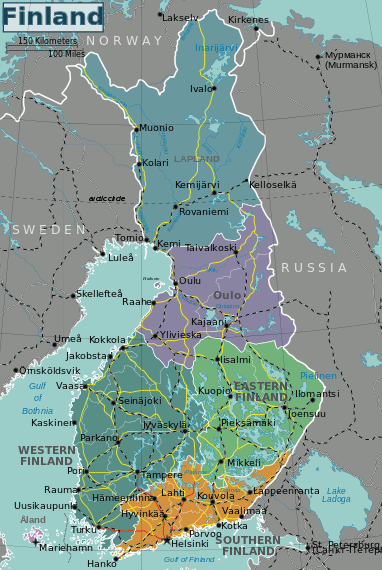Introduction

Finland (Suomi in Finnish) is the EU's fifth largest and most sparsely populated country, with only 16 people per km². One fourth of Finland's 5.4 million inhabitants live in the Helsinki metropolitan area. Only seven cities outside the Greater Helsinki have a population exceeding 100,000, the largest of which being Tampere with 300,000 inhabitants in its urban area.
Finland is a flat country occupied mostly by forests (69% of the land area) and lakes (10%). It is famous for its large population of elks (moose), but is also one of the last regions in Europe where grey wolves, wolverines and brown bears can be found.
Finnish is one of the few languages in Europe that does not belong to the Indo-European linguistic family. Like Estonian, its closest relative, and Hungarian, a much more distant relative, Finnish is an Uralic language.
The Finns are a population isolate due to the fact that they descended from a tiny ancestral population in the Middle Ages. Genetic studies have shown that the Finns (including the Sami in Lapland) have the lowest level of Middle Eastern admixture in Europe, and are consequently the closest living relatives of Paleolithic northern Europeans.
Finland is so far the only Nordic country to have joined the Eurozone. Electronics are the country's largest industry, and Nokia its largest and most famous company. Angry Birds, the popular mobile phone game, was developed in Finland.
Famous people from Finland include (chronologically): the "father of the Finnish written language" Mikael Agricola, the philologist and Kalevala author Elias Lönnrot, the classical composer Jean Sibelius, the ski jumper Matti Nykänen, Linux engineer Linus Torvalds, and the F1 drivers Mika Häkkinen and Kimi Räikkönen.
History
The written history of Finland starts in the 12th and 13th centuries, when its territory was annexed to and Christianised by Sweden. At the time, the Finnish population was of barely 30,000 people. Finland remained an integral part of Sweden until 1809, when it was conquered by the armies of Tsar Alexander I, and became an autonomous Grand Duchy within the Russian Empire. Finland's population reached the threshold of one million soon afterwards.
In 1917, the Bolshevik Revolution prompted Russia to withdraw from World War I. This led to the declaration of Finland's independence, achieved in December 1917, followed by the Finnish Civil War in the early months of 1918. During the Second World War, Finland lost Finnish Karelia to the Soviet Union. Like Sweden, Finland opted to stay neutral in the Cold War. Industrialisation started only after WWII, but was rapid and efficient. Finland is now one of the most hi-tech and wealthiest countries in the world.
Though not a Germanic country, Finland has close cultural ties with Scandinavian countries and is often mistakenly thought of as a Scandinavian country itself.